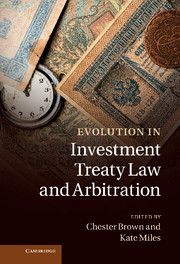Book contents
- Frontmatter
- Contents
- Contributors
- Editors' preface and acknowledgements
- Table of cases
- Table of Treaties
- Part I Introduction
- Part II Shifts in fundamental character
- Part III Actors in international investment law
- Part IV The new significance of procedure
- Part V Engagement with cross-cutting issues
- 21 Protecting intellectual property rights under BITs, FTAs and TRIPS: Conflicting regimes or mutual coherence?
- 22 Stabilisation clauses and sustainable development: Drafting for the future
- 23 A new investment deal in Asia and Africa: Land leases to foreign investors
- 24 Thirst for profit: Water privatisation, investment law and a human right to water
- 25 Economic development at the core of the international investment regime
- 26 Regulatory chill and the threat of arbitration: A view from political science
- Part VI Conclusions
- Index
- References
25 - Economic development at the core of the international investment regime
from Part V - Engagement with cross-cutting issues
Published online by Cambridge University Press: 05 December 2011
- Frontmatter
- Contents
- Contributors
- Editors' preface and acknowledgements
- Table of cases
- Table of Treaties
- Part I Introduction
- Part II Shifts in fundamental character
- Part III Actors in international investment law
- Part IV The new significance of procedure
- Part V Engagement with cross-cutting issues
- 21 Protecting intellectual property rights under BITs, FTAs and TRIPS: Conflicting regimes or mutual coherence?
- 22 Stabilisation clauses and sustainable development: Drafting for the future
- 23 A new investment deal in Asia and Africa: Land leases to foreign investors
- 24 Thirst for profit: Water privatisation, investment law and a human right to water
- 25 Economic development at the core of the international investment regime
- 26 Regulatory chill and the threat of arbitration: A view from political science
- Part VI Conclusions
- Index
- References
Summary
Introduction
It is well known that a dispute will only fall within the jurisdiction of the International Centre for Settlement of Investment Disputes (ICSID) if the dispute directly arises out of an ‘investment’, as is provided by Article 25(1) of the Convention for the Settlement of Investment Disputes between States and Nationals of other States (ICSID Convention). However, not only does the ICSID Convention fail to provide any definition of what constitutes an ‘investment’, the drafters of the ICSID Convention, in fact, made an express decision not to include such a definition. This absence has given rise to interesting issues of interpretation as ICSID tribunals have sought to arrive at an understanding of how the term ‘investment’ should be properly understood for the purposes of the ICSID Convention. Various elements have been proposed in defining what is and what is not ‘an ICSID investment’, including the existence of contribution, certain duration, risk, participation, and contribution to the development of the host State. In considering these characteristics of an ‘investment’, this chapter argues that the most important element is the aim of furthering the economic development of the host State. Indeed, it is argued that this constitutes the most critical element in any definition of investment as it is understood under the ICSID Convention.
At a fundamental level, the arguments put forward in this chapter are grounded in the nature of the State itself. Inarguably, the welfare and development of their nationals and residents is of primary concern to States. It is also clear that in promoting that development, significant amounts of capital can be required. Accordingly, a range of strategies is often adopted by States to attract that capital, a key one of which is enhancing the domestic investment climate through entering into international legal instruments that provide protection to foreign investment. In concluding international investment agreements (IIAs), States agree to grant international protection to foreign investments – and, in return, they expect to attract the capital needed to promote their economic development. For host States, this assumption is a central, if often unarticulated, rationale behind the conclusion of the agreement. For this reason, it is important to consider the intention of States when entering into IIAs and to gain a proper understanding of why the treaties were concluded. This understanding could, in turn, influence the interpretation of the IIAs' provisions under international law. The argument presented in this chapter is that this type of analysis should play an important role in the interpretation and application of IIAs, and in adjudicating fair solutions to the disputes that might arise between investors and States.
- Type
- Chapter
- Information
- Evolution in Investment Treaty Law and Arbitration , pp. 586 - 605Publisher: Cambridge University PressPrint publication year: 2011
References
- 4
- Cited by



